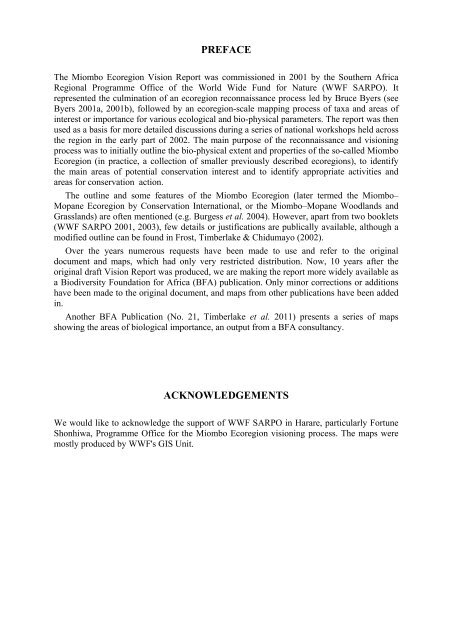Miombo Ecoregion Vision Report - Biodiversity Foundation for Africa
Miombo Ecoregion Vision Report - Biodiversity Foundation for Africa
Miombo Ecoregion Vision Report - Biodiversity Foundation for Africa
Create successful ePaper yourself
Turn your PDF publications into a flip-book with our unique Google optimized e-Paper software.
PREFACE<br />
The <strong>Miombo</strong> <strong>Ecoregion</strong> <strong>Vision</strong> <strong>Report</strong> was commissioned in 2001 by the Southern <strong>Africa</strong><br />
Regional Programme Office of the World Wide Fund <strong>for</strong> Nature (WWF SARPO). It<br />
represented the culmination of an ecoregion reconnaissance process led by Bruce Byers (see<br />
Byers 2001a, 2001b), followed by an ecoregion-scale mapping process of taxa and areas of<br />
interest or importance <strong>for</strong> various ecological and bio-physical parameters. The report was then<br />
used as a basis <strong>for</strong> more detailed discussions during a series of national workshops held across<br />
the region in the early part of 2002. The main purpose of the reconnaissance and visioning<br />
process was to initially outline the bio-physical extent and properties of the so-called <strong>Miombo</strong><br />
<strong>Ecoregion</strong> (in practice, a collection of smaller previously described ecoregions), to identify<br />
the main areas of potential conservation interest and to identify appropriate activities and<br />
areas <strong>for</strong> conservation action.<br />
The outline and some features of the <strong>Miombo</strong> <strong>Ecoregion</strong> (later termed the <strong>Miombo</strong>–<br />
Mopane <strong>Ecoregion</strong> by Conservation International, or the <strong>Miombo</strong>–Mopane Woodlands and<br />
Grasslands) are often mentioned (e.g. Burgess et al. 2004). However, apart from two booklets<br />
(WWF SARPO 2001, 2003), few details or justifications are publically available, although a<br />
modified outline can be found in Frost, Timberlake & Chidumayo (2002).<br />
Over the years numerous requests have been made to use and refer to the original<br />
document and maps, which had only very restricted distribution. Now, 10 years after the<br />
original draft <strong>Vision</strong> <strong>Report</strong> was produced, we are making the report more widely available as<br />
a <strong>Biodiversity</strong> <strong>Foundation</strong> <strong>for</strong> <strong>Africa</strong> (BFA) publication. Only minor corrections or additions<br />
have been made to the original document, and maps from other publications have been added<br />
in.<br />
Another BFA Publication (No. 21, Timberlake et al. 2011) presents a series of maps<br />
showing the areas of biological importance, an output from a BFA consultancy.<br />
ACKNOWLEDGEMENTS<br />
We would like to acknowledge the support of WWF SARPO in Harare, particularly Fortune<br />
Shonhiwa, Programme Office <strong>for</strong> the <strong>Miombo</strong> <strong>Ecoregion</strong> visioning process. The maps were<br />
mostly produced by WWF's GIS Unit.


